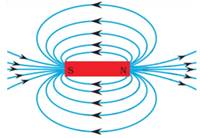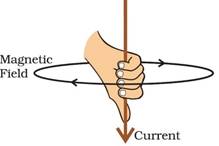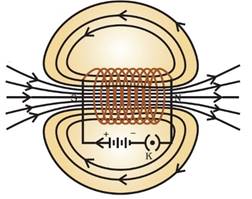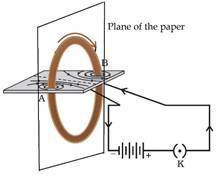i) What is a magnetic field? How can the direction of magnetic field lines at a place be determined?
ii) State the rule for the direction of the magnetic field produced around a current carrying conductor. Sketch the pattern of field lines due to a current flowing through a straight conductor.
OR
i) What is a solenoid? Sketch the pattern of field lines of the magnetic field through and around a current carrying solenoid.
ii) Consider a circular loop of wire lying in the plane of the table. Let the current pass through the loop clockwise. Apply the right-hand rule to find out the direction of the magnetic field inside and outside the loop.

i. (a) Magnetic field is a quantity that has both direction and magnitude.
(b) The direction of the magnetic field is taken to be the direction in which a north pole of the compass needle moves inside it.
(c) Therefore, it is taken by convention that the field lines emerge from north pole and merge at the south pole (note the arrows marked on the field lines in the diagram). Inside the magnet, the direction of field lines is from its south pole to its north pole.
(d) Thus, the magnetic field lines are closed curves. The relative strength of the magnetic field is shown by the degree of closeness of the field lines. The field is stronger, that is, the force acting on the pole of another magnet placed is greater where the field lines are crowded (see diagram). No two field-lines are found to cross each other. If they did, it would mean that at the point of intersection, the compass needle would point towards two directions, which is not possible.
(ii) Right Hand Thumb Rule

A convenient way of finding the direction of magnetic field associated with a current-carrying conductor is given in the diagram. Imagine that you are holding a current-carrying straight conductor in your right hand such that the thumb points towards the direction of current. Then your fingers will wrap around the conductor in the direction of the field lines of the magnetic field, as shown in the diagram. This is known as the right-hand thumb rule.
OR PART
i. A coil of many circular turns of insulated copper wire

wrapped closely in the shape of a cylinder is called a solenoid. The pattern of the magnetic field lines around a current-carrying solenoid is shown in the diagram. One end of the solenoid behaves as a magnetic north pole, while the other behaves as the south pole. The field lines inside the solenoid are in the form of parallel straight lines. This indicates that the magnetic field is the same at all points inside the solenoid. That is, the field is uniform inside the solenoid.
ii. 
The direction of the magnetic field as per the right-hand thumb rule is shown on the plane in the diagram. The direction is outwards the plane of the paper in the inner part of the loop and is directed inside the plane of the paper in the outer region of the loop.